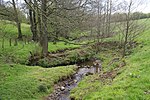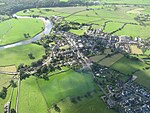Bremetennacum

Bremetennacum, ([brɛmɛˈteːnːakʊm]), or Bremetennacum Veteranorum, was a Roman fort on the site of the present day village of Ribchester in Lancashire, England (grid reference SD650350). (Misspellings in ancient geographical texts include Bremetonnacum, Bremetenracum or Bresnetenacum.) The site is a Scheduled Monument.The site guarded a crossing-point of the River Ribble. The first known Roman activity was the building of a timber fort, believed to have been constructed during the campaigns of Petillius Cerialis around AD 72/3. This was replaced by a stone fort in the 2nd century. For most of its existence the fort was garrisoned by Sarmatian auxiliaries, first stationed in Britain by Marcus Aurelius in 175. Prior to that it is suggested that the fort was garrisoned by the Ala II Asturum from Spain, but there is some uncertainty about this. Pottery evidence indicates that the fort was occupied for most of the 4th century until the end of the Roman period.
Excerpt from the Wikipedia article Bremetennacum (License: CC BY-SA 3.0, Authors, Images).Bremetennacum
Church Street, Ribble Valley
Geographical coordinates (GPS) Address External links Nearby Places Show on map
Geographical coordinates (GPS)
| Latitude | Longitude |
|---|---|
| N 53.81035 ° | E -2.530828 ° |
Address
Bremetennacum
Church Street
PR3 3YE Ribble Valley
England, United Kingdom
Open on Google Maps









